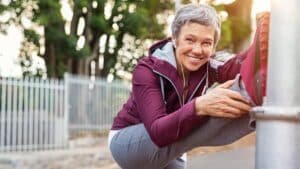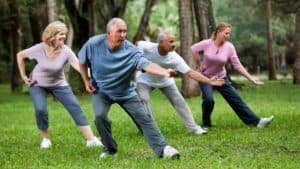
I just became eligible for Medicare, the US health insurance for those 65 and older. Doctor Charlene scheduled a Welcome to Medicare visit, and to be honest, the process was sobering. Answering the questionnaire truthfully resulted in me being classified as “at risk for falls” because I have rugs in my hallway, no grab bars in my bathroom and I walk around barefoot at home.
Add to this a recent diagnosis of “age-related osteoporosis” via DEXA scan (Dual-energy X-ray absorptiometry – a means of measuring bone mineral density), and I walked away from that experience feeling quite unsettled.
Me! A Certified Personal Trainer. A Restorative Exercise instructor.
I do not see myself as a person at risk for injury from falling in my home. I was literally in the process of writing an article about movements to self-assess and improve balance. I teach a class series called Better Balance, for gosh sake!
And yet, here I am. Doing what I do with unsettling news, which is to gather the smartest information I can find, make sense of it and share it with my friends and peers – smart and capable women like you.
Is Your Risk Age-Related or Behavior-Related?
Many of the so-called “age-related” risks and diagnoses are found in sedentary seniors. The ones who don’t get anywhere close to the minimum recommended 150 minutes of exercise per week. Here’s a startling statistic: 77% of Americans of all ages do not get the minimum amount of exercise.
Then there are those who take their exercise in bigger doses – say a full hour per day of movement of some kind – running, walking, biking, yoga, Zumba. These folks get double (!) the minimum and then spend the rest of their day sitting in front of a screen reading, working or crafting, etc. These people are considered “actively sedentary.”
What I have learned from five years of teaching movement to women in their 60s, 70s and 80s, is that it is never too late to move better. And everybody can move more. For many of us, that means finding new motivations or goals and a support community, even if it is just one person. We already know our bodies will be better for it.
Moving More Is Part of the Solution
For most of us facing age-related diagnoses, moving more and moving better is a big part of the solution to aging well. It’s really less about how old we are than it is about how many years we’ve been doing (or not doing) enough movement.
Maybe it’s been a while since you participated in a regular exercise program. Or the activities that you’ve always enjoyed now feel harder on your body or bring you pain. You might be a person who has been active your whole life and want to stay that way!
Whatever your situation, you need to:
- Restore and maintain the function of your joints,
- Strengthen your muscles and bones,
- Feel confident moving in the ways you want to, especially moving in balance.
Check Your Strength with a Simple Balance Test
Take this quick assessment of strength, one of the risk factors for falls. Falls are the leading cause of injuries for folks age 65 and older. The most common injury from a fall is a bone fracture.
Single Leg Standing Balance Test
- Stand on a hard floor near a table or countertop for support.
- Bend one knee and lift the foot – if you’re left-handed, stand on your left leg and lift the right foot; do the opposite if you’re right-handed. You don’t need to lift it high, just enough to keep it off the floor.
- Now, without holding onto anything, slowly count the number of seconds you can hold that position without putting your foot back down.
- Repeat the test 3 times, and then add up your total time and divide it by 3 to find your average balance time. (For example, if test 1 was 4 seconds, test 2 was 8 seconds, and test 3 was 6 seconds, you’d add up 4, 8, and 6 to get 18. Divide by 3, and your average balance time is 6 seconds.)
Increase the Challenge
You can try retaking this same test with your eyes closed for a greater challenge. Compare your results below.
| With Eyes Open | With Eyes Closed | ||
| Age | Balance Time (seconds) | Age | Balance Time (seconds) |
| 40 – 59 | 25 – 27 secs. | 40 – 59 | 15 – 20 secs |
| 60 – 69 | 20 – 25 | 60 – 69 | 9 – 12 |
| 70 – 79 | 10 – 15 | 70 – 79 | 7 – 8 |
| 80 | 5 – 6 | 80 | 4 – 5 |
You Can Improve Your Balance with Practice
It’s never too late to train your body and brain to balance. There’s a lot of good research that shows how important being able to balance is to longevity. And not just on one leg at a time in a controlled environment, but in a wide variety of real life movements like carrying groceries, dragging a garden hose around the yard, filling bird feeders, dusting the highest shelves, playing with your pet, practicing qigong, dancing, walking, running.
Read more about it in this New York Times article (no subscription necessary) that includes five exercises you can do right now to improve your balance.
The number #1 recommendation for preventing falls is exercise. Start with the single leg balance test and keep going with a balance- and strength-focused exercise program. The National Institute on Aging also recommends that you have your vision and hearing tested regularly, check the side effects of medications, get enough sleep and take steps to make your home safer.
My number #1 exercise for building balance is the Calf Raise. You can do it anywhere, even while waiting at the airport. Click here for a video of four ways to work on strength with Calf Raises.
How did you do with the Single Leg Standing Balance Assessment? Does your regular exercise program build strength and balance? When have you felt unsteady or off-balance?





